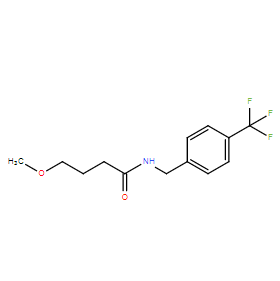| Cas No.: | 202402-01-5 |
| Chemical Name: | 4-methoxy-N-{[4-(trifluoromethyl)phenyl]methyl}butanamide |
| Synonyms: | Get 73,Get-73,Get73 |
| SMILES: | COCCCC(=O)NCC1=CC=C(C=C1)C(F)(F)F |
| Formula: | C13H16F3NO2 |
| M.Wt: | 275.27 |
| Description: | GET73 is a γ-hydroxybutyric acid (GHB) analog, a naturally occurring neurotransmitter. GET73 has anti-alcohol and anxiolytic properties. GET73 significantly affects glutamate transmission in the hippocampus[1][2][3]. |
| In Vivo: | GET73 (5–50 mg/kg; i.g.) exerts an anxiolytic effect in Sprague-Dawley rats exposed to the elevated plus maze (EPM) test[3]. Animal Model: Male SD rats (200-300 g and 300–350 g)[3] Dosage: 5 mg/kg, 10 mg/kg, 25 mg/kg, 50 mg/kg Administration: Oral gavage Result: Exerted an anxiolytic effect in rats exposed to the elevated plus maze (EPM) test. |
| In Vitro: | GET73 (1 µM, 10 µM; 1 hour) 1 hour before and during chronic ethanol exposure prevents ethanol-induced a reduction of cell viability, an alteration of cytoskeleton, a decrease in extracellular glutamate levels and an increase of reactive oxygen species production[1]. Cell Viability Assay[1] Cell Line: Rat hippocampal neurons Concentration: 0.1 µM, 1 µM, 10 µM Incubation Time: 1 hour Result: Prevented the ethanol (75 mM, 4 days) -induced MTT reduction. |
| References: | [1]. Tomasini MC, et al. GET73 Prevents Ethanol-Induced Neurotoxicity in Primary Cultures of Rat Hippocampal Neurons. Alcohol Alcohol. 2016 Mar;51(2):128-35. [2]. Ferraro L, et al. GET73 modulates rat hippocampal glutamate transmission: evidence for a functional interaction with mGluR5. Pharmacol Rep. 2011;63(6):1359-71. [3]. Loche A, et al. Anti-Alcohol and Anxiolytic Properties of a New Chemical Entity, GET73. Front Psychiatry. 2012 Feb 14;3:8. |

 To enhance service speed and avoid tariff delays, we've opened a US warehouse. All US orders ship directly from our US facility.
To enhance service speed and avoid tariff delays, we've opened a US warehouse. All US orders ship directly from our US facility.




















